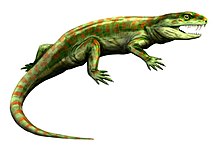Pelycosaur
| Pelycosaurs | |
|---|---|

| |
| Mounted skeleton of Dimetrodon mileri, Harvard Museum of Natural History | |
| Scientific classification | |
| Domain: | Eukaryota |
| Kingdom: | Animalia |
| Phylum: | Chordata |
| Superclass: | Tetrapoda |
| Clade: | Reptiliomorpha |
| Clade: | Amniota |
| Clade: | Synapsida |
| Informal group: | †Pelycosauria Cope, 1878 |
| Groups included | |
| Cladistically included but traditionally excluded taxa | |
Pelycosaur (
Because it excludes the advanced synapsid group
Etymology
The modern word was created from Greek pélyx meaning 'basin' and saûros meaning 'lizard'.[7] The term pelycosaur has been fairly well abandoned by paleontologists because it no longer matches the features that distinguish a clade.[6]
Pelycosauria is a
Evolutionary history

The pelycosaurs appear to have been a group of synapsids that have direct ancestral links with the mammals, having differentiated teeth and a developing hard palate. The pelycosaurs appeared during the Late Carboniferous and reached their apex in the early part of the Permian, remaining the dominant land animals for some 40 million years. A few continued into the Capitanian, but they experienced a sharp decline in diversity in the late Kungurian.[8] They were succeeded by the therapsids.
Description

Some species were quite large, growing to a length of 3 metres (10 ft) or more, although most species were much smaller. Well-known pelycosaurs include the genera Dimetrodon, Sphenacodon, Edaphosaurus, and Ophiacodon.[9]
Pelycosaur fossils have been found mainly in Europe and North America, although some small, late-surviving forms are known from Russia and South Africa.
Unlike
At least two pelycosaur
Taxonomy


In phylogenetic nomenclature, "Pelycosauria" is not used formally, since it does not constitute a group of all organisms descended from some common ancestor (a clade), because the group specifically excludes the therapsids which are descended from pelycosaurs. Instead, it represents a paraphyletic "grade" of basal synapsids leading up to the clade Therapsida.[12]
In 1940, the group was reviewed in detail, and every species known at the time described, with many illustrated, in an important monograph by Alfred Sherwood Romer and Llewellyn Price.[13]
In traditional classification, the order Pelycosauria is paraphyletic in that the therapsids (the "higher" synapsids) have emerged from them. That means Pelycosauria is a grouping of animals that does not contain all descendants of its common ancestor, as is often required by phylogenetic nomenclature. In evolutionary taxonomy, Therapsida is a separated order from Pelycosauria, and mammals (having evolved from therapsids) are separated from both as their own class. This use has not been recommended by a majority of systematists since the 1990s,[6] but several paleontologists nevertheless continue using this word.[14][12]
The following classification was presented by Benton in 2004.[15]
- Order Pelycosauria*
- Suborder Caseasauria
- Family Eothyrididae
- Family Caseidae
- Suborder Eupelycosauria
- Family Varanopidae
- Family Ophiacodontidae
- Family Edaphosauridae
- Infraorder Sphenacodontia
- Family Sphenacodontidae
- Suborder Caseasauria
- Order Therapsida
See also
Notes
- JSTOR 982652.
- ^ Carroll, R.L. 1988. Vertebrate Paleontology and Evolution. WH Freeman and Company, New York ISBN 0-7167-1822-7
- ISBN 0471278483.
- .
- ^ PMID 17848370.
- ^ ISBN 978-0-520-26647-6.
- ^ Colbert, Edwin H. (Edwin Harris); Knight, Charles Robert (1951). The dinosaur book: the ruling reptiles and their relatives. New York: McGraw-Hill. p. 152.
- PMID 34966586.
- ISBN 978-1-11851-093-3.
- S2CID 84302993.
- ^ Tracy, C.R.; Turner, J.S.; Huey, R.B. (1986). "A biophysical analysis of possible thermoregulatoryadaptations in pelycosaurs". In MacLean, P.D.; Roth, J.J.; Roth, E.C.; Hotton, N. (eds.). Ecology and Biology of Mammal-Like Reptiles. Washington, DC: Smithsonian Press. pp. 195–205.
- ^ S2CID 91487577.
- doi:10.1130/SPE28-p1.
- S2CID 56425905.
- ISBN 978-0-632-05637-8.
References
- ISBN 3-89937-032-5.
External links
- "Introduction to the Pelycosaurs". UCMP.
- "Synapsida - Pelycosauria". Palaeos. Archived from the original on 2006-03-13.
